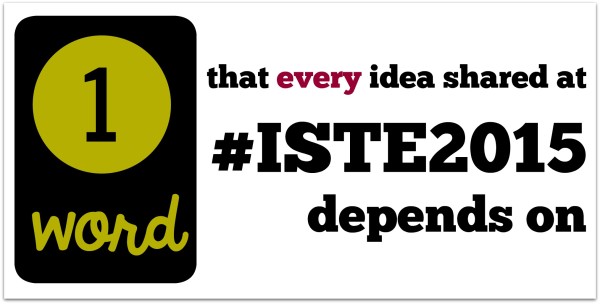I’ve spent the last 4 days at ISTE surrounded by 21,000 incredibly passionate educators. I’ve learned more about makerspaces, genius hour, flipped learning, STEM, STEAM, BYOD, PLCs, project-based learning, game-based learning, differentiated learning, personalized learning, and approximately 4,752 different apps and web tools to make it all possible.
And when I reflect back on big themes and takeaways amongst all the craziness that is the world’s largest ed tech conference, I realize that every single one of these practices hinge upon a single word.
Trust.
Do we choose to trust our students to take ownership of their own learning? Do we trust them enough to create classrooms where they’re not dependent on us in order to learn?
Do we choose to trust ourselves? To believe that our instincts as educators have value, that we know how to meet our students’ needs despite what policymakers demand? Do we choose to trust our ability to tune into our own needs and take care of ourselves, to listen to that small voice that tells us when to rest, to breathe, to take some time to nurture other aspects of our lives?
Do we choose to trust one another in our schools? Do we trust our teachers to exercise autonomy and professional expertise? Do we have faith that deep down, every educator wants to do great things for kids even when that vision has been trampled on and nearly lost?
Do we choose to trust each other in the education community as a whole? Do we choose to include and learn from people who don’t look like us? Do we believe that conversations with people who think differently than we do are opportunities for growth and gaining fresh perspective?
As I think back on the last few days, I’ve realized that trust is the essential ingredient in making every worthwhile vision in education become a reality. We need trust when we put technology in the hands of kids and teachers. We need trust to create a positive school culture; to empower students; to move away from test prep and embrace real learning. We need trust to accomplish the big and small tasks ahead of us as we work to transform our schools into places where teachers and kids love to be.

So what do we do when the trust isn’t there?
1) We start by leading the change and being trustworthy ourselves.
Rather than wasting energy in complaining that students or parents or colleagues or admin create obstacles in our work, we can choose to lead by example, and be the unshakeable presence that others know they can rely on.
2) We start by trusting ourselves to take risks in our teaching.
When we see that the sky doesn’t fall after a less-than-perfect lesson, we can trust ourselves to practice reflecting, learning, and getting back out there again. Our ideas are worth trying, and they’re worth sharing. We just have to have enough faith in ourselves to do it.
3) We start by building a community of trust with our students.
We can tell our kids that we want them to have choice in how they learn and demonstrate their learning, that we want them to explore the topics they’re passionate about…and that we want to give them the opportunity to earn our trust so they can blaze new trails in the classroom. It can be really scary to think about students directing their own learning, and with some kids, it’s a downright terrifying proposition. But we can teach our students to be trustworthy. We can slowly give them more ownership of the classroom, guiding them through increased levels of responsibility, and helping them get back on track when they mess up. We can trust that they will rise to our expectations when they understand that we’re all in this together, when they know that their teacher and peers are there to support and encourage.
A great teacher IS the silver bullet in education. We have the power. @stumpteacher #iste2015 Click To TweetIn his closing keynote, Josh Stumpenhorst said that we’re all “waiting for superman”, but she or he is already sitting in our classrooms. We are the change the we’ve been waiting for. It starts with us, in our schools and our classrooms.
Whatever your takeaway from ISTE (or any other professional learning you’ve done), you can be certain it’s going to require trust in order to implement your vision fully. So will you take the next step? Will you challenge yourself not just to learn, but to take action?
You can innovate. You can create change. You can do what’s best for kids.
And it all starts with trust.

Angela Watson
Founder and Writer
Sign up to get new Truth for Teachers articles in your inbox
Discussion
Leave a Reply
OR

Join our
community
of educators
If you are a teacher who is interested in contributing to the Truth for Teachers website, please click here for more information.
















Hi Angela,
Why do you think so many teachers have difficulty trusting their colleagues? And do you have any ideas about how we could begin to change this sorry situation?
Lisa G.
Great question, Lisa. Unfortunately, there is not much of a collaborative school culture in many places. Sometimes colleagues can be threatened by those who are innovating because they feel it makes them look bad. One way to address this is to celebrate the small successes of all teachers so that those who aren’t taking on massive projects still feel like their contributions and baby step changes to instructional practices are valued.